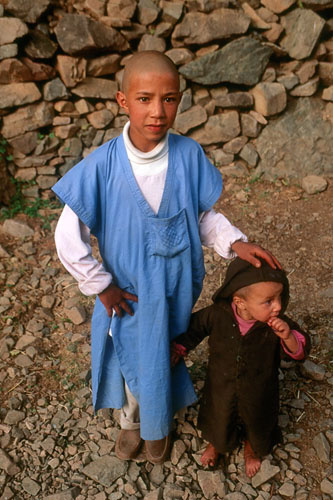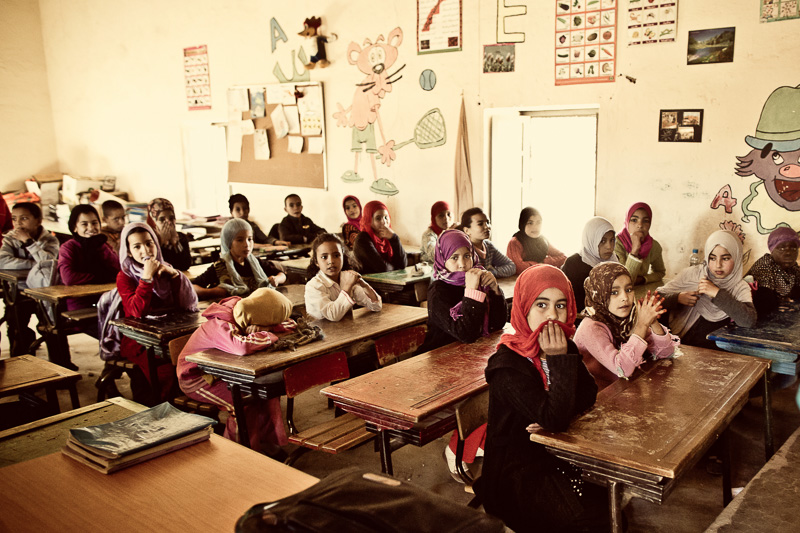Hello, salaama aleikum, welcome to Morocco, the kingdom in northern Africa.
The Kingdom of Morocco lies in the northwest of Africa between the Atlantic Ocean and the Mediterranean Sea. Morocco is just a stone's throw from Europe. The northernmost point of the country lies opposite Spain.

For comparison: Morocco is almost twice as big as the Republic of Germany.
Landscapes
Morocco is a very mountainous country. The Er Rif runs along the coast of the Mediterranean Sea. The Atlas Mountains stretch from the south west to the north east and are in some areas densely forested. It rains often in the Atlas Mountains and in winter it snows a lot. The Sahara Desert begins south of the mountains. Morocco has claimed the thinly-populated region of Western Sahara as a part of its territory, but the people of Western Sahara want to be independent.
Rabat- capital city and residential city

Rabat has been the capital city since Morocco gained its independence and is one of the four sultan cities. Here is the King of Morocco's residence. The city was once one of the border fortresses of the Berber people but was expanded to a city in the 12th Century. The coastal location once made the city an eldorado for pirates. The pirate republic of Bou Regreg grew rich through piracy and looting, as well as- sadly- the slave trade.
Markets in Marrakech
 The inland city of Marrakech was founded in the 11th Century by the Berber people and is today an important trade centre. The lively centre of Djemaa el-Fna has a long and bloody history. In the past, convicted criminals were executed here. Today it is a colourful marketplace with storytelling, bakeries and snakecharmers. The city also has one of the largest mobile trading platforms in Africa. The streets are very busy in the evenings- fortunetellers and magicians offer their services and children and teenagers do their homework in the light of the streetlamps, as they don't have enough space at home or they don't have electricity.
The inland city of Marrakech was founded in the 11th Century by the Berber people and is today an important trade centre. The lively centre of Djemaa el-Fna has a long and bloody history. In the past, convicted criminals were executed here. Today it is a colourful marketplace with storytelling, bakeries and snakecharmers. The city also has one of the largest mobile trading platforms in Africa. The streets are very busy in the evenings- fortunetellers and magicians offer their services and children and teenagers do their homework in the light of the streetlamps, as they don't have enough space at home or they don't have electricity.
The stalls in the Souks (canopied markets) of Morocco aren't colourfully jumbled as ours back home are; they are organised by product. For example, there is one street for fruit and meat traders, one for carpet traders and one for jewelers. In front of the stalls, the traders drink a cup of mint tea with their customers, bargain a while over prices and discuss news. You don't often see western clothes in the markets- men and women wear Djebellas, long robes or caftans.

Peoples and Languages
 Arabs and Berber people live in Morocco and almost all inhabitants are muslim. The Berber people are the oldest inhabitants of the county. They adopted the islamic religion from the arabian holy warriors in the 8th Century. While following the islamic religion, they maintained a completely different culture than that of the Arabs. The Berber women draw patterns on their faces and hands with henna because they believe this will protect them from bad luck. They have preserved the beliefs of the Berber people und also celebrate other festivals than Arabs do. They live in sun dried brick houses. The houses are made of clay and have to be re-plastered every year. The bricks can keep the room temperature at comfortable level in the hot desert regions.
Arabs and Berber people live in Morocco and almost all inhabitants are muslim. The Berber people are the oldest inhabitants of the county. They adopted the islamic religion from the arabian holy warriors in the 8th Century. While following the islamic religion, they maintained a completely different culture than that of the Arabs. The Berber women draw patterns on their faces and hands with henna because they believe this will protect them from bad luck. They have preserved the beliefs of the Berber people und also celebrate other festivals than Arabs do. They live in sun dried brick houses. The houses are made of clay and have to be re-plastered every year. The bricks can keep the room temperature at comfortable level in the hot desert regions.
Schools and Education
School is compulsory in Morocco, just as it is by us, but this only applies to children between the ages of 6 and 13. The language of instruction is Arabic, which is the official language in Morocco. Although most girls and boys go to school, not all parents can send their children to school. Children have to help with the farming and the industrial processing of food and other products. Also, books and pencils are expensive. Within the last decade, schooling has improved and so now almost all childen can read and write.
Agriculture and Industry

Half of the Moroccans work in the agriculture or fishing industry. Wheat, sugarcane, dates, olives and citrus fruits are grown. More than 750 000 tons of fish are caught each year. Morocco controls about three quarters of the phosphate reserves in the world, which is a huge amount, when you think what we use phosphate for. We need it for the production of fertilisers, cleaning products and toothpaste. Coal, iron ore, lead and other metals are found in Morocco. There are large oil resources in the north east. The tourism industry in Morocco has developed into one of the most important industries in the country. The warm climate, the enchanting beaches and the old cities, such as Fes, Tanger and Marrakech, attract millions of tourists each year.
History

![]() More on the history of Morocco
More on the history of Morocco
Morocco Today

In 1956, after many years of being a French colony, Morocco became a constitutional Monarchy. The King has a strong position in the politics of Morocco. Conservative parties support the monarchy. Morocco has many economic problems and is still the poorest country in North Africa, with over 5 million people living beneath the poverty line. The youth and college-educated especially struggle to find adequate jobs. Even though school is compulsory for children from the age of 6, half of the population cannot read or write.
Fairytales from Morocco

Even today, the storytellers tell their stories for money in the marketplaces of Marrakech. Like all their ancestors over the centuries, they captivate the audience with stories of old kingdoms, of wealth and poverty, of unlucky love and sinister plots. They are like the stories from the Arabian Nights. In addition, they also tell many stories about animals of the desert. The stories are about a competition between the fox and the hedgehog or the lion and the donkey, who fight about who is cleverer. One story, which is told in the Arabian Peninsula and North Africa, is the story of Bayad and Riyad.







